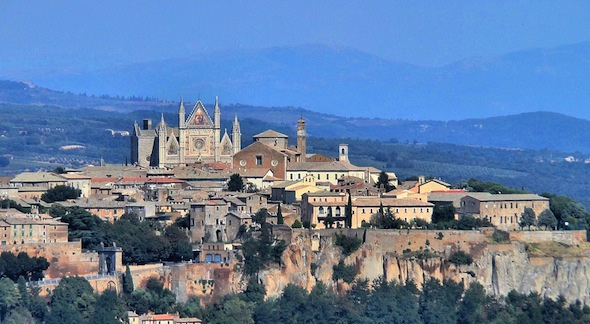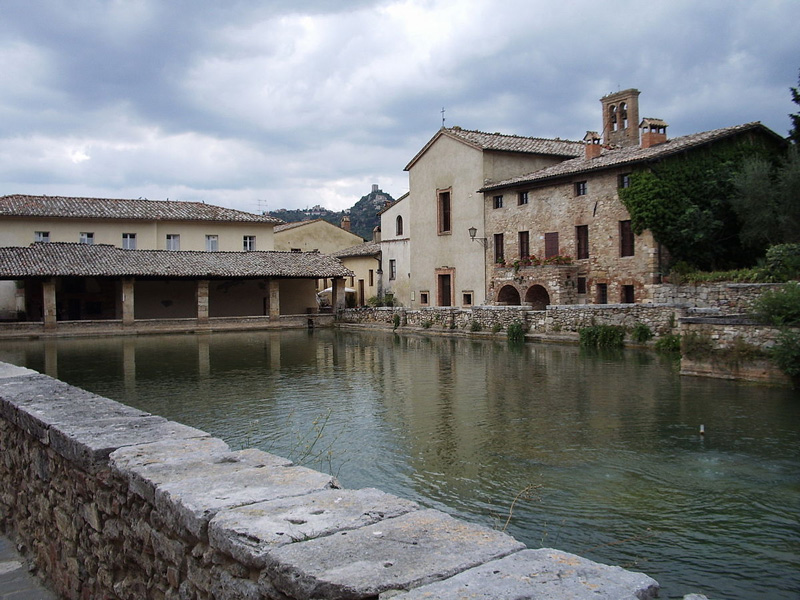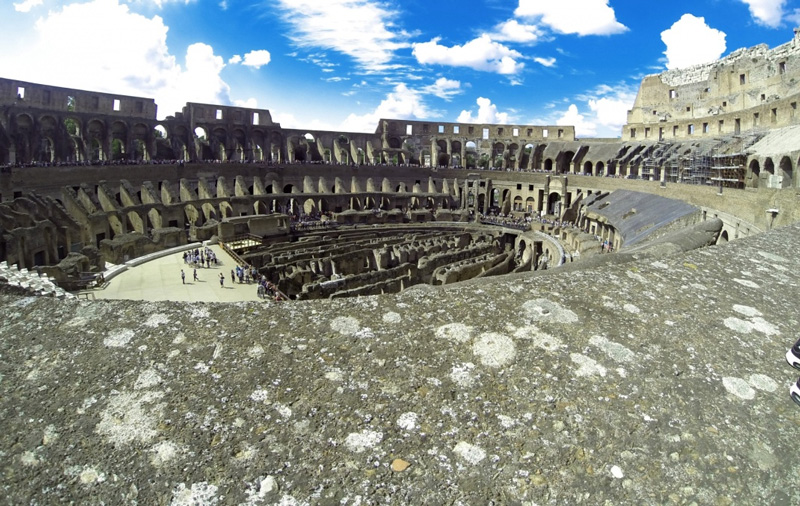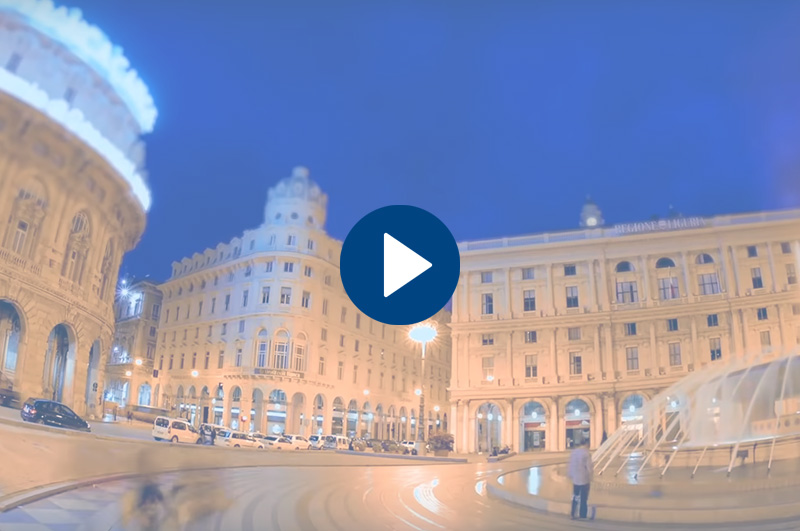5-day GALILEO PRIVATE TOUR
Orvieto, Tuscany, Florence and Rome
From the marvellous sceneries of Tuscany, to Florence, the cradle of the Renaissance, and finally Rome the "Eternal City", you dream of something better?
WHAT'S INCLUDED:
Accommodations in Double Room with Continental Breakfast (*):
- Day 1: 3* to 5* Hotel in Orvieto city centre
- Day 2: 3* to 5* Hotel in Val d’Orcia area
- Day 3: 3* to 5* Hotel in Florence city centre
- Days 4 & 5: 3* to 5* Hotel in Rome city centre
(*) The Hotel list is available upon request
Transfers (**):
- Day 1: Pick up at your accommodation in Rome and transfer to your accommodation in Orvieto – Stopover in Civita da Bagnoregio
- Day 4: Transfer to your accommodation in Rome
(**)All transfers by private car (2 pax)/ minivan (3 to 6 pax)/ minibus (7 to 10 pax)
Private Guided Visits / Tours (***) / Activities:
- Day 2: Full-day excursion to Val d’Orcia area: Pienza and Bagno Vignoni - Visit of a local wine cellar with tastings – Drop off at your accommodation in Val d’Orcia
- Day 3: Full-day excursion to Siena and San Gimignano – Drop off at your accommodation in Florence
- Day 4: 3-hour private guided walking tour of Florence with an Authorised Tourist Guide
- Day 5: Full-day private walking tour of Rome city centre with an Authorised Tourist Guide
(***) All tours by private car (2 pax)/ minivan (3 to 6 pax)/ minibus (7 to 10 pax)
- Admission Tickets to:
- Colosseum and Imperial Fora in Rome
- Vatican Museums with the Sistine Chapel in Rome
- Galleria dell’Accademia in Florence
Full emergency assistance 24 hours/day by our Back Office
List of recommended restaurants and deli shops along the itinerary
All taxes
Options:
- Pick up at Rome Airport /Railway Station on the day before the start of the tour
- Accommodation in Rome the night before the start of the tour
- Drop off at Rome Airport /Railway Station at the end of the tour
- Other options upon request
Day 1 – ORVIETO & CIVITA DI BAGNOREGIO
Benvenuti in Italia, welcome to Orvieto!
Orvieto in Umbria is perhaps the most beautiful hill town in Italy, perched up on a volcanic rock, its history dating back to the Etruscans.
Although just an hour from Rome, the architecture is different, with many of the buildings constructed out of “tufo”, a volcanic rock. Orvieto’s main attraction is its 14th-century Cathedral – a masterpiece of Gothic architecture with a glistening façade of stained glass, mosaics and sculptures. Another attraction is St. Patrick’s Well, a 62-meter-deep (203 feet) feat of engineering characterized by two spiral staircases that wind around the well (yet never meet), with 248 steps down to the water. A pleasant guided tour along a straightforward route makes it possible to know Orvieto’s underground world, created by its ancient inhabitants over about 2,500 years of uninterrupted digging. A tour at the discovery of a millenary, surprising and unexpected “Underground City”, you will surely enjoy it!
At lunch, don’t miss “salumi di cinghiale o cervo” (boar or deer sausage) and pecorino cheese and taste the region's prized white truffle oil together with the delicious white wine of the area, Orvieto Classico!
Civita di Bagnoregio, the spectacular “borgo” slowly sliding towards the valley, is also known as the “Dying City”. The town is famous for its unique position atop a plateau of friable volcanic tuff overlooking the Tiber river valley. It is in constant danger of destruction as the edges of the plateau collapse due to erosion, leaving the buildings to crumble as their underlying support falls away.

Day 2 – VAL D'ORCIA
Val d’Orcia is one of the most fascinating places in Italy, included by UNESCO in the list of World Heritage Sites. Its landscape is a part of the agricultural hinterland of Siena, redrawn and developed when it was integrated into the city-state's territory in the 14th and 15th centuries to reflect an idealized model of good governance and create an aesthetically pleasing picture. The landscape’s distinctive aesthetics, flat chalk plains with almost conical hills and fortified settlements on top, inspired many artists. Their images have come to exemplify the beauty of well-managed Renaissance agricultural landscapes.
Your first stop will be in Pienza, “Pio’s town”: here, Pope Pius II decided to build the perfect palazzo for his papal court according to the project of an “Ideal City" drawn up by artists such as Piero della Francesca. From the loggia of the Palace, you will enjoy a breath-taking panorama of the valley. Pienza is also the area of the typical “Pecorino di fossa” cheese, an absolute delight to the palate!
Then, you will get to Montalcino, one of the prettiest hill towns in Tuscany. Around the village, rows of olive trees, precious grapevines and yellow fields create an enchanting landscape. Here you may visit a Brunello winery to taste the most famous Supertuscan wine, probably the best Italian red!
Then, you will stop in Bagno Vignoni, a tiny and charming village where the main square is a pool 49 meters long and 29 wide. Several hot springs, whose therapeutic qualities have been renowned since antiquity, bubble up from its bottom! All this creates a pleasant sensation; leaving will be hard!

Day 3 – SIENA and SAN GIMIGNANO
In Siena, the city of the Palio, you will walk on the famous Piazza del Campo, the concave square where horses run twice a year in a dangerous race that symbolizes the city’s freedom. On the days of the Palio, the whole town goes crazy; read about it in our BLOG. Indeed, you will not forget the colour of frontages and roofs, the renowned colour “Sienna”, a pigment first produced during the Renaissance, that makes the city lovely and warm. And don’t forget to taste the Senese sweets: “cantucci” (biscuits with toasted almonds), “ricciarelli” (soft biscuits with icing sugar), “panforte”(cake with fruit nuts and spices) and “cavallucci” (biscuits with honey, walnut, candied fruits and spices. Travellers who love dessert will be delighted!
In the afternoon, you will stroll with your head upwards along the streets of one of the most beautiful cities in Tuscany, San Gimignano, also known as the "Medieval Manhattan", thanks to its old and impressive 14 towers that dominate the town skyline. Originally the towers were 72, built by patrician families probably to demonstrate their wealth and power. Seven of San Gimignano's towers are around Piazza del Duomo; the tallest one is Torre Grossa, 54 meters high, dating back to 1298.

Day 4 – FLORENCE
Welcome to Florence, the land of Giotto and Dante!
Despite its international fame and greatness, Florence is also a small city whose history has been interwoven with that of its passionate citizens for more than one thousand years
In Piazza Duomo, you will be astonished by the Duomo with the incredible Brunelleschi’s dome, a masterpiece of art and architecture whose building techniques are still covered by a veil of mystery. Beside it, Giotto’s Belltower and the Baptistery, one of the oldest buildings in the city, with its famous bronze doors made by no and Ghiberti in the 14th and 15th centuries. In Piazza della Signoria, you will walk in the middle of bronze and marble masterpieces by Giambologna and Cellini inside the marvellous Loggia dei Lanzi, and will admire the imposing Palazzo Vecchio, one of the symbols of Florence and still the seat of government of the city. You may also spare some time to relax, visiting a typical market for shopping, strolling through the city's pedestrian streets, and crossing the oldest bridge in Florence, “Ponte Vecchio” (Old Bridge), rich in jewellery shops.
Your itinerary may include Galleria dell’Accademia, hosting Michelangelo's David, the most famous sculpture in the world. The David was uncovered and shown to the Florentines on September 8, 1504, and with its height of 4 meters, the impeccable physical features and the political significance that the iconography of David had taken over the previous century left the Florentines of the time speechless and has done the same ever since with visitors from all over the world.
Florence is also the main Italian centre for the production of high-quality leather goods. Florentine artisans are so famous that many fashion brands have opened factories in the city or close to it due to their high skill and the continuous inspiration designers take from the town’s masterpieces. The area around Piazza Santa Croce, in particular, hosts numerous leather shops and workshops.
Thanks to the tradition of Tuscan tanneries, there is no better place to find shoes for all tastes than Florence: from the creations, designed and produced by hand by skilled craftsmen, to the extensive collections available in stores, renewed every season. Above all, Ferragamo (also worth seeing the museum), Gucci and Prada for refinement and elegance. If you prefer a simpler style, many shops specialise in handmade shoes and sandals across the river Arno.
At lunch, you may enjoy “Panino con Lampredotto” in a typical Florentine market. At dinner, taste the simple yet unforgettable recipes of the Tuscan tradition, such as "Crostini", "Panzanella", and "Peposo". And remember, Florence is the home of "Fiorentina" steak! In case you are a vegetarian, don’t worry: Tuscan cuisine offers tasty alternatives like “Pappa al Pomodoro” or “Ribollita” (read our BLOG to know more about Tuscan Cuisine).

Day 5 - ROME
Here you are in Rome, where ancient history, excellent art and religious icons mix uniquely! Start from the 2,000-year-old Colosseum, the most famous amphitheatre in the world, and the Imperial Fora, the administrative and monumental centre of the Roman Empire. On the Palatine Hill, the majestic ruins of the Palaces of Augusto, Tiberius and Domiziano still dominate theCircus Maximus valley, 50-meter-high structures giving a unique view of the city.
Close to the Colosseum, inside the Church of San Pietro in Vincoli, you may see the famous Michelangelo sculpture of “Moses”. Supposedly, Michelangelo, admiring his Moses, enraptured by the so realistic shapes of the imposing statue, was struck by a violent outburst of anger and exclaimed the famous phrase “Perchè non parli?" (Why don't you speak!?)
From Piazza Venezia, you will head inside “Baroque” Rome, starting with the Pantheon, dedicated to worshipping every god (Pan-every Theon-divinity), now the memorial chapel of great Italian people of the past. After that, don’t miss the Church of St. Louis of the French, famous for the cycle of paintings of the great Caravaggio at the end of the 16th century. Then Piazza Navona, the splendid oval area corresponding to the underground Domitianus’ Stadium, with the gorgeous Fountain of the Four Rivers by Lorenzo Bernini in the centre of the Piazza. And finally, Fontana di Trevi, the city’s biggest and most famous fountain, a Rome icon renowned worldwide: here, statues of travertine marble stand over the cliff and the broad basin in an epic representation of the Kingdom of the Oceans.
At the end of the day, sit down at a local "trattoria" or "fiaschetteria", the typical home-style restaurant, to taste authentic Roman cuisine in a popular and cheerful atmosphere (for an overview of Roman cuisine, see our BLOG).
On the other side of River Tevere, Vatican Hill is the home of the tiny state of Vatican City. The immense St. Peter’s Basilica dominates the extraordinary Piazza framed by the magnificent four-column-deep colonnades designed by Gian Lorenzo Bernini. The Basilica is an extraordinary casket for some of the world's most beautiful works of art, such as Michelangelo’s “La Pietà” and Bernini’s “Baldacchino”, along with works of the most important artists of the Renaissance, from Raphael to Canova.
Inside the Vatican Museums, you will be astonished by the exquisite and unique Sistine Chapel, the “Sancta Sanctorum” (“Holy among the Holiest” in Latin) of the Roman Catholic Church, where cardinals gather to elect the new Pope! The Sistine Chapel takes its name from Pope Sixtus IV della Rovere (pontiff from 1471 to 1484), who had the old Cappella Magna restored between 1477 and 1480. The decoration of the walls was executed by a team of painters, Pietro Perugino, Sandro Botticelli, Domenico Ghirlandaio and Cosimo Rosselli, assisted by their respective shops.
Julius II della Rovere (pontiff from 1503 to 1513), the nephew of Sixtus IV, decided to partly alter the decoration, entrusting the work in 1508 to Michelangelo Buonarroti, who painted the Ceiling and, on the upper part of the walls, the lunettes. The nine central panels show the Stories of Genesis, from the Creation to the Fall of Man, to the Flood and the subsequent rebirth of humanity with the family of Noah. Again, towards the end of 1533, Clement VII de' Medici (pontiff from 1523 to 1534) asked Michelangelo to paint the Last Judgement on the altar wall. How could he refuse? And, in fact, he did not, but painted his vision of the Judgement, with a powerful and furious Jesus Christ.
The tour is over, but the memories of a fantastic journey will accompany you for a lifetime!
Arrivederci for another tour with VITOR, Visit Italy on the Road.

